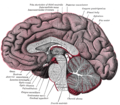Interventricular foramina (neuroanatomy)
| Interventricular foramina | |
|---|---|
 | |
 Coronal section of lateral and third ventricles. (Foramen not displayed, but relationship between ventricles can be observed.) | |
| Details | |
| Part of | Ventricular system |
| Identifiers | |
| Latin | foramen interventriculare, foramen Monroi |
| NeuroNames | 447 |
| TA98 | A14.1.08.411 |
| TA2 | 5641 |
| FMA | 75351 |
| Anatomical terms of neuroanatomy | |

In the brain, the interventricular foramina (or foramina of Monro) are channels that connect the paired lateral ventricles with the third ventricle at the midline of the brain. As channels, they allow cerebrospinal fluid (CSF) produced in the lateral ventricles to reach the third ventricle and then the rest of the brain's ventricular system. They also contain choroid plexus, a specialized CSF-producing structure, that is continuous with that of the lateral and third ventricles, and which is also present in the fourth ventricle.
Structure
The crescent-shaped interventricular foramina are located on the medial and inferior aspect of the lateral ventricles. Each foramen is bounded by the fornix and thalamus. The lumens of the foramina have a diameter of several millimeters.
Clinical significance
Inflammation, tumor, or other conditions that may occlude the foramina may lead to internal hydrocephalus.
History
The foramina were named after the Scottish physician and University of Edinburgh graduate Alexander Monro, who first described the structures in his 1783 publication, Observations on the Structure and Functions of the Nervous System. They had previously been identified by the 17th century anatomist Raymond Vieussens.
Additional images
-
Velum interpositum.
-
Median sagittal section of brain.
-
Interventricular foramen
References
- Kiernan, John A. (2005). Barr's The Human Nervous System: An Anatomical Viewpoint. Lippincott Williams & Wilkins. p. 220. ISBN 0-7817-5154-3.
- History of Neuroscience, from the University of Washington



